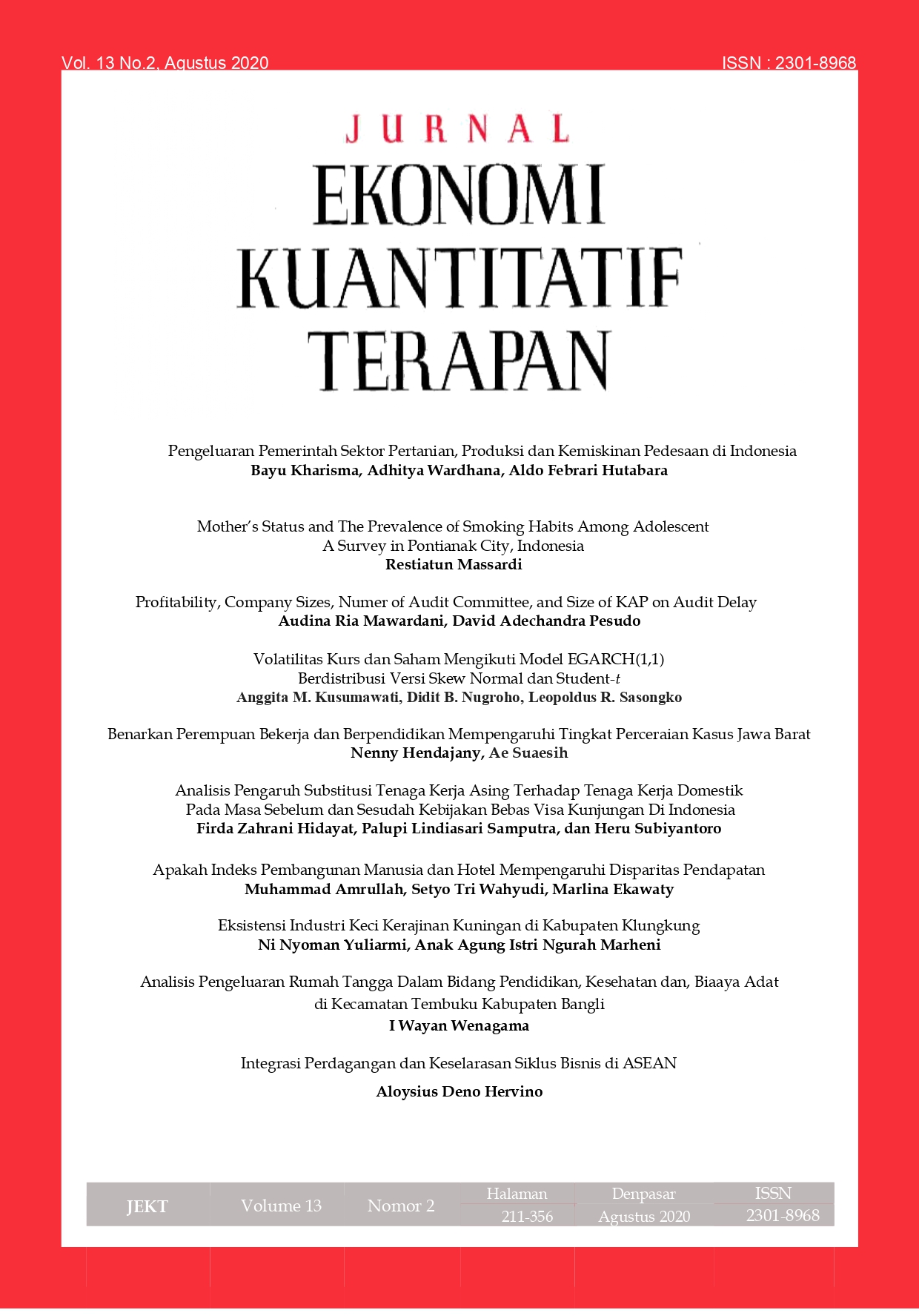Volatilitas Kurs dan Saham Mengikuti Model EGARCH(1,1) Berdistribusi Versi Skew Normal dan Student-t
Abstract
Studi ini membandingkan kinerja pencocokan model volatilitas GARCH(1,1) dan EGARCH(1,1) pada return kurs dan saham. Model mengasumsikan empat distribusi berbeda untuk error dari return: Normal, Skew-Normal (SN), Alpha-Skew Normal (ASN), dan Student-t. Data aset keuangan yang digunakan sebagai analisis perbandingan yaitu data kurs beli US Dollar (USD) dalam periode harian dari Januari 2010 sampai Desember 2017 dan data indeks saham FTSE100 dalam periode harian dari Januari 2000 sampai Desember 2013. Studi ini membandingkan metode Generalized Reduced Gradient (GRG) Non-Linier di Solver Excel dan metode Adaptive Random Walk Metropolis (ARWM) untuk mengestimasi model. Hasil menunjukkan bahwa metode GRG Non Linear Solver Excel memberikan estimasi yang serupa dengan metode ARWM dan tidak melanggar kendala model. Lebih lanjut, berdasarkan nilai Akaike Information Criterion (AIC), kedua data pengamatan menyediakan bukti bahwa model dengan distribusi Student-t adalah yang terbaik, diikuti oleh distribusi SN yang lebih baik daripada model dengan distribusi ASN dan Normal. Nilai AIC telah menyarankan model EGARCH(1,1) berdistribusi Student-t sebagai model pencocokan terbaik untuk kedua data pengamatan.
Downloads
References
Akaike, H. (1974). A New Look at the Statistical Model Identification. IEEE Transactions on Automatic Control, 19(6), 716–723.
Altun, E. (2019). The generalized Gudermannian distribution: inference and volatility modelling. Statistics, 53(2), 364–386.
Ardia, D., & Hoogerheide, L. F. (2010). Bayesian estimation of the GARCH(1,1) model with Student-t innovations. The R Journal, 2(2), 41–47.
Azzalini, A. (1985). A class of distributions which includes the normal ones. Scandinavian Journal of Statistics, 12(2), 171–178.
Azzalini, A. (2011). Skew-normal distribution. In M. Lovric (Ed.), International encyclopedia of statistical science. Springer Berlin Heidelberg.
Blangiardo, M., & Cameletti, M. (2015). Spatial and Spatio-temporal Bayesian Models with R - INLA. Chichester: John Wiley & Sons.
Bollerslev, T. (1986). Generalized autoregressive conditional heteroskedasticity. Journal of Econometrics, 31(3), 307–327.
Bucevska, V. (2013). An empirical evaluation of GARCH models in Value-at-Risk estimation: Evidence from the Macedonian Stock Exchange. Business Systems Research, 4(1), 49–64.
Chen, M.-H., & Shao, Q.-M. (1999). Monte Carlo estimation of Bayesian credible and HPD intervals. Journal of Computational and Graphical Statistics, 8(1), 69–92.
Choi, S. W., & Lam, D. M. H. (2017). Comparing two methods-agreeing to disagree. Anaesthesia, 72(5), 651–653.
Deschamps, P. J. (2006). A flexible prior distribution for Markov switching autoregressions with Student-t errors. Journal of Econometrics, 133(1), 153–190.
Elal-olivero, D. (2010). Alpha skew normal distribution, 29(December), 224–240.
Engle, R. F. (1982). Autoregressive conditional heteroscedasticity with estimates of the variance of United Kingdom inflation. Econometrica, 50(4), 987–1007.
Hansen, P. R., & Lunde, A. (2005). A forecast comparison of volatility models: Does anything beat a GARCH(1,1)? Journal of Applied Econometrics, 20(7), 873–889.
Jarque, C. M. (2011). Jarque-Bera test. In M. Lovric (Ed.), International Encyclopedia of Statistical Science (pp. 701–702). Berlin, Heidelberg: Springer.
Kronman, S. (2015). The volatility of tomorrow - Comparison of GARCH and EGARCH models applied to Texas Instruments stock returns. Stockholms Universitet.
Lama, A., Jha, G. K., Paul, R. K., & Gurung, B. (2015). Modelling and forecasting of price volatility: An application of GARCH and EGARCH models. Agricultural Economics Research Review, 28(1), 73–82.
Nelson, D. B. (1991). Conditional heteroskedasticity in asset returns: A new approach. Econometrica, 59(2), 347–370.
Nugroho, D. B., Kurniawati, D., Panjaitan, L. P., Kholil, Z., Susanto, B., & Sasongko, L. R. (2019). Empirical performance of GARCH, GARCH-M, GJR-GARCH and log-GARCH models for returns volatility. Journal of Physics: Conference Series, 1307(1), 012003.
Nugroho, D. B., & Susanto, B. (2017). Volatility modeling for IDR exchange rate through APARCH model with student-t distribution. In AIP Conference Proceedings (Vol. 1868, p. 040005). AIP Publishing LLC.
Nugroho, D. B., Susanto, B., Prasetia, K. N. P., & Rorimpandey, R. (2019). Modeling of returns volatility using GARCH(1,1) model under Tukey transformations. Jurnal Akuntansi Dan Keuangan, 21(1), 12–20.
Nugroho, D. B., Susanto, B., & Rosely, M. M. M. (2018). Penggunaan MS Excel untuk estimasi model GARCH(1,1). Jurnal Matematika Integratif, 14(2), 71–81.
Safrudin, I. M., Nugroho, D. B., & Setiawan, A. (2015). Estimasi berbasis MCMC untuk returns volatility di pasar valas Indonesia melalui model ARCH berdistribusi normal dan Student-t. In Prosiding Sendika UMP (pp. 34–39).
Salim, F. C., Nugroho, D. B., & Susanto, B. (2016). Model volatilitas GARCH(1,1) dengan error Student-t untuk kurs beli EUR dan JPY terhadap IDR. Jurnal MIPA, 39(1), 63–69.
Sarkar, A., & Roy, M. (2019). A study of volatility of five major stock indices of Indian stock market. In S. Bandyopadhyay & M. Dutta (Eds.), Opportunities and Challenges in Development. Springer Nature Singapore.
Wennstrom, A. (2014). Volatility forecasting performance: Evaluation of GARCH type volatility models on Nordic equity indices. Royal Institute of Technology, Stockholm, Sweden.




















